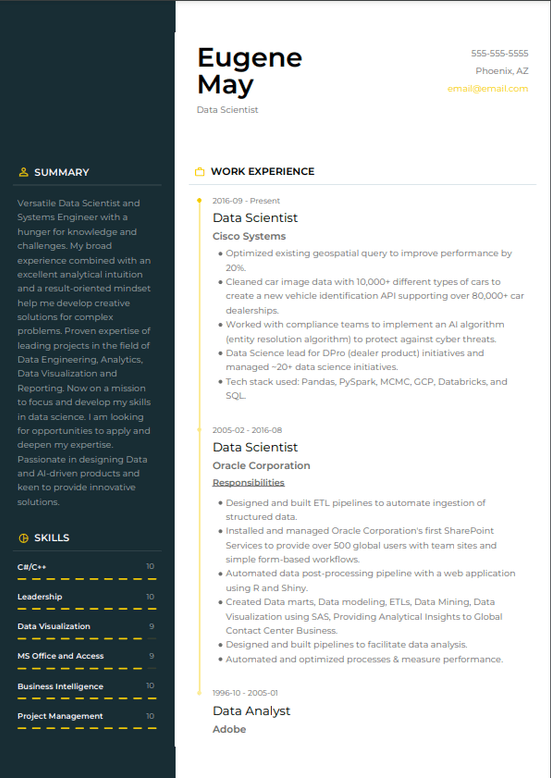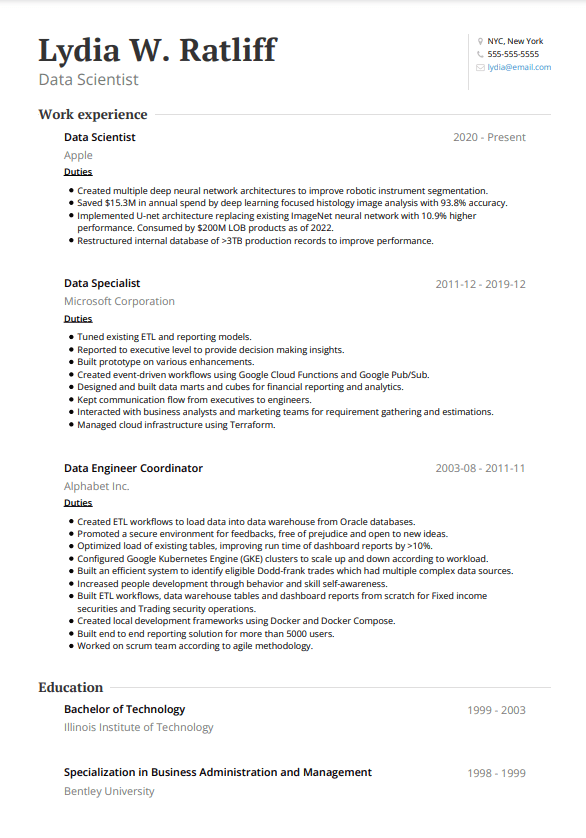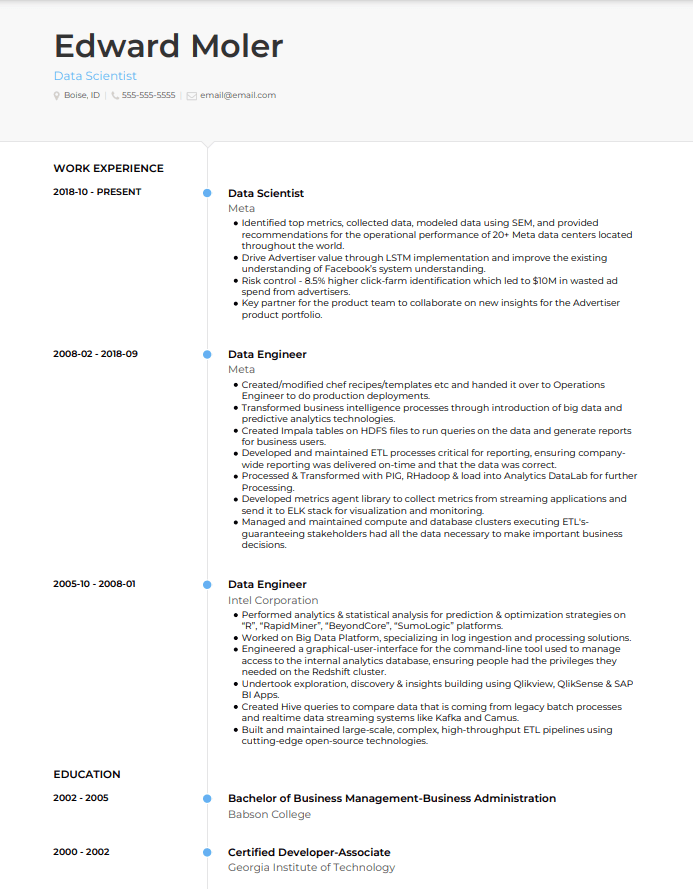Data Scientist Resume Example
This guide provides you with Data Scientist resume examples to use to create your own resume with our easy-to-use resume builder. Below you'll find our how-to section that will guide you through each section of a Data Scientist resume and you'll be closer than ever to landing your dream job.

Want to write a great Data Scientist resume?
You should know this. Most data science resumes that hiring managers receive scream:
- “Wrote a digit recognition algorithm with 95% accuracy”
- “Used Tensorflow to do this really simple detection”
- “Used this off the shelf software for ‘X’”
Reality is, most entry level data science resumes rarely go beyond the common pattern listed above. The experienced data science resumes on the other hand fail to communicate the complexity, scale or innovation performed.
Fixing just that would make your data science resume stand out from 90% of the other applications that a hiring manager would receive.
In this guide, we are going to take you a step ahead though. Whether you are looking to land a FAANG/MAANG data science role or work for an innovative startup - we are going to show you how to create a Data Scientist resume that will win 99% of the time!
Data Scientist Resume Example

FAANG Data Scientist Resume Example

Senior Data Scientist Resume Example

Let’s start with an overview of what it takes to create a great Data Scientist resume.
How to write a Data Scientist Resume?
To write a Data Scientist resume:
- Highlight either your business impact or data science innovation.
- Provide context to what type of ML work you performed
- Make sure to add the programming languages you use
- If applicable, show your ability to architect ML systems
- Highlight your publications
If you avoided those, you would struggle to justify how your work made an impact. For example, it isn’t uncommon for us to come across statements like these in data science resumes: “Leverage my skills in data cleaning, data analysis and predictive modeling to achieve business goals” - statements like these are bad for your resume.
However, if you are seeking an entry level data science position - consider the following while writing your entry level data science resume:
- Highlight your thesis and projects - they make a big difference when there’s no work experience.
- While listing your projects, display your thoughtfulness in approaching the problem and solving it.
- Adding programming languages adds weight to your data science resume. However, do not list yourself as an “expert” if you are a recent graduate.
- Add a link to your portfolio or Github.
Do you know about FAANG data science roles - a Github profile is the most commonly sought after resource to see how proactive you are, what you’ve built on your own and your code quality.
The Best Data Science Resume Format
The quality of a good data science resume format would be:
- A format that allows you to list your skills and experience in one (or max two pages).
- Consistent throughout leveraging not more than two fonts and shouldn’t have too many colors on it.
- Uses bullet lists instead of large paragraphs to highlight a Data Scientist’s skills and experience.
Keeping those three qualities of a good Data Scientist resume’s format, the best format for you would be:
- Reverse chronological resume format - if you are an experienced Data Scientist.
- Hybrid resume format - if you are an entry level Data Scientist who lacks the experience, but has skills and data science projects to show.
Experienced Data Scientist’s Resume vs Entry Level Data Scientist’s Resume?
What separates an experienced Data Scientist’s resume from an entry level resume is: #1 Business impact: An entry level Data Science resume can often only display a thoughtful approach to solving a problem, but a job winning Data Scientist resume should be able to show the impact of work performed.
E.g. an entry level Data Scientist resume would have “Leverage data cleaning, database management and deep learning for text classification”
Vs an experienced Data Scientist’s resume would say “Created real time text classification capabilities through hybrid deep learning models (attention mechanism position and focal loss) for City of Chicago to handle traffic violation in low light conditions. Convolution attention mechanism used was Bi-LSTM with CABO model.”
#2 Technically descriptive: As most entry level Data Scientist resumes don’t involve innovating and leveraging sophisticated technologies. It isn’t too difficult to find phrases like “Wrote a machine learning model to recognize Chinese characters”
Vs an experienced Data Scientist’s resume should say “Led digitization of 3TB of Chinese character data by using RAN of aggregation module, mapping encoder and a character analysis decoder. Outperformed existing DenseRAN by 33.6%, with 57.9% higher computing efficiency.”
As you can see, a good data science resume would change radically with the experience of a Data Scientist. But, it isn’t uncommon to see experienced Data Scientists write their resumes as if they are an entry level professional.
When you write meaningfully, a hiring manager not only is able to see the impact you made, but is also able to see if you have worked on similar business or technology projects in the past as theirs.
Data Scientist Resume: Summary or Objective?
Here’s a rule of thumb for you - write a data science resume objective only when you are an entry level professional or when you are transitioning from another role (e.g SWE) to data science. If you are already working as a Data Scientist, write a resume summary instead.
With that in mind, let’s take a look at how to write an excellent Data Scientist resume summary.
How to Write a Data Scientist Resume Summary (with Examples)
To write a great Data Scientist resume summary, include the following information:
- State your years of data science experience (e.g. 10+ years of experience in…”).
- List your top technical specialization (e.g. LSTM, GAN, etc).
- List your top business skills (e.g. customer segmentation, image processing, pricing analysis, market basket analysis, etc).
- Finally, add relevant certifications and awards that you have received.
Let’s check two examples of good and bad Data Scientist resume summary samples that will illustrate better.
Entry Level Data Science Resume Summary - Bad
I am a Data Scientist with experience of analytics and applied data science experience with a focus on strategic initiatives targeting business scalability, process improvement, and efficiency.
Entry Level Data Science Resume Summary - Professional
Data Scientist with 9 months of analytics and applied data science experience to support $100M maintenance operations using survival models and PowerBI dashboards. Business expertise: performance drift, revenue leakage and regression analysis for cost estimation.
In the two Data Scientist resume examples above, we see that both have noticeable entry level experience. But when you read the second Data Scientist’s resume summary, one can clearly see why the second data science resume would win.
If you are an entry level Data Scientist too, here’s a template that you can copy to write your resume summary: “Data Scientist with {x} {months/years} of analytics and applied data science experience to support {operations} using {data science technique}. Business expertise: {expertise 1}, {expertise 2} and {expertise 3}.”
Experienced Data Science Resume Summary - Bad
Experienced Data Scientist experienced in designing, building and deploying fast, accurate, scalable and secure machine learning applications in the cloud.
We list this as a bad data science resume summary mainly because it won’t help you stand out. Let alone beat 99% of the other data science resumes. Every word added to your Data Scientist resume allows you to leave an impact - in this case you won’t make any.
Experienced Data Science Resume Summary - Professional
Data Scientist with 10+ years of experience in building high performing NLP products. Expert at neural architecture optimization of large feature spaces for performance gains. Author of Lin-ML - used by more than 100,000+ machine learning developers.
How to Write a Data Scientist Resume Objective (with Examples)
The most important factors to consider when writing your Data Scientist resume objective are:
- Add your top skills, area of expertise or specialization in it.
- Mention what you are passionate about.
- List your top recognizable achievements.
Entry Level Data Science Resume Objective - Bad
An enthusiastic entry-level data scientist, a NCSU graduate. I have hands-on work experience in machine learning models and a portfolio of Data Science projects.
Entry Level Data Science Resume Objective - Professional
An enthusiastic entry-level data scientist with hands-on work experience in creating RNN and Modular NNs to text and speech problems. Kaggle Master, Top 5% on Stackoverflow for Python and winner of Google Universal Image Embedding challenge(GAN).
When you compare those two Data Science resume examples above it isn’t too hard to see the following:
- Good Data Scientist resumes will be very specific about their past projects and top technologies.
- Poor Data Scientist resumes will be generic or verbose without any specific skills.
Common mistakes to avoid while writing a resume summary or objective include:
- Writing more than 3 lines in a resume summary or objective. If it is a wall of text, it’s going to negatively impact your application.
- Listing yourself as an expert - it is better to let your skills and accomplishments do the job instead.
- Being too vague about your interest and technology used in projects/work experience.
The idea here is to leave a good first impression, a hook that will allow the hiring manager to continue to read further with interest.
Need more examples? Here are 6 Data Scientist resume objective examples.
How to Describe your Data Scientist Experience on Resume?
Describing your data science experience on your resume should not be taken lightly. It is always one of the top few items on a hiring manager’s checklist. Despite that importance, it isn’t uncommon to see very poorly written work history on a Data Scientist’s resume.
To write a winning Data Scientist resume, you should describe your experience by following the STAR method. Using the STAR method it is very easy to highlight a problem you solved, how thoughtful you were in solving the data science problem and what results you achieved.
Let’s checkout a couple of examples to see how
Bad Data Scientist Resume Experience Sample
Data Scienstist
- Worked within the Data Science team in the SF office.
- Taking responsibility for coordinating data partnerships, and improving existing modeling processes.
- Spearheading data for new lines of business.
- Support internal data modeling needs for stakeholders and cross functional teams.
- Utilizing a plethora of technologies in my day-to-day work.
Looking at this Data Scientist’s resume, any hiring manager would wonder:
- If they have the right experience to solve the data science challenges they are looking to solve?
- They failed to communicate the impact of their work - would they be able to communicate their insights in a way that everyone can understand?
- What functions did they serve in this role?
Hiring managers spend as little as 7 seconds scanning a resume. They scan your summary/objective, job titles, work experience and your skills. If they don’t find what they are looking for, they discard your application - all in 7 seconds!
That’s why we suggest you write your work history section in a way that reduces their efforts to find the information they are looking for and leave an impact at the same time.
Let’s now look at a few examples of work history sections of good data science resumes.
Data Scientist Resume Work Experience
Data Scientist
- Optimized existing geospatial query to improve performance by 20%.
- Cleaned car image data with 10,000+ different types of cars to create a new vehicle identification API supporting over 80,000+ car dealerships.
- Worked with compliance teams to implement an AI algorithm (entity resolution algorithm) to protect against cyber threats.
- Data Science lead for DPro (dealer product) initiatives and managed ~20+ data science initiatives.
- Tech stack used: Pandas, PySpark, MCMC, GCP, Databricks, and SQL
Machine Learning Data Science Resume Work Experience
ML Data Scientist
- Created multiple deep neural network architectures to improve robotic instrument segmentation.
- Saved $15.3M in annual spend by deep learning focused histology image analysis with 93.8% accuracy.
- Implemented U-net architecture replacing existing ImageNet neural network with 10.9% higher performance. Consumed by $200M LOB products as of 2022.
- Restructured internal database of >3TB production records to improve performance.
FAANG/MAANG Data Science Resume Work Experience
Meta Data Scientist
- Identified top metrics, collected data, modeled data using SEM, and provided recommendations for the operational performance of 20+ Meta data centers located throughout the world.
- Drive Advertiser value through LSTM implementation and improve the existing understanding of Facebook’s system understanding.
- Risk control - 8.5% higher click-farm identification which led to $10M in wasted ad spend from advertisers.
- Key partner for the product team to collaborate on new insights for the Advertiser product portfolio.
How to Write a Data Science Resume With No Experience?
When you have no data science specific experience, consider writing a section that focuses on your portfolio of data science projects instead. The type of projects that you can include are:
- Recognizable competitions like Kaggle
- Projects listed on your Github profile
- Any significant academic projects performed
Platforms like Kaggle are often used by companies that are hiring entry level/experienced data science talent. And, your Github projects will enable an employer to see what you are capable of, along with your code quality.
Companies like Uber, Microsoft, etc actively collaborate with universities in the form of academic partnerships. That’s why academic data science projects bring in substantial weight to your data science resume for a hiring manager.
How to List your Data Science Projects on Resume?
To list your data science projects on your resume, create a separate section for your projects. For each project add the following information:
- Title of the project
- Short description of the project involving the problem you solved, the solution you used and technology involved.
Data Scientist Resume Example - Projects
Instacart Market Basket Analysis Model building - used XGBoost with two gradient boosted tree models (predicting reorders, predicting zero orders). Characteristic of each of these models include:
- Reorder model - XGBoost with 6 gradient boosted tree models (GBDT, random seed)
- Zero order model - XGBoost with 17 boosted tree models (with a step shrinkage)
Project insights involved:
- Identified patterns where a user won’t repurchase an item.
- Days since reorder plays an important role.
- Items reordered more frequently vs those that aren’t.
- When a user is unlikely to make a reorder.
How to List Your Education on your Data Science Resume
To list your education on your Data Scientist Resume create a new section for education and list your education credentials in it. Your education section should be concise if you are not an entry level Data Scientist.
Example Education Section in an Experienced Data Scientist Resume
Masters in Data Science, 3.9 GPA Texas A&M University
BS, Data Science, 4.0 GPA Texas A&M University
Example Education Section in an Entry Level Data Scientist Resume
BS, Data Science, 4.0 GPA Texas A&M University
- Coursework taken: Big Data 101, GeoSpatial Computing 309 and Machine Learning.
- Thesis: Leveraging GeoSpatial computing with LIDAR data to predict flooding for urban environments.
- Elected as President of Texas A&M Data Science club of 500+ members.
Top 20 Data Science Resume Skills for 2022
- Machine Learning
- Deep Learning
- Data Visualization
- Python
- R
- Shiny
- Tableau
- PowerBI
- SQL
- T-SQL
- RNN
- CNN
- LSTM
- Neural Networks
- PyTorch
- Tensorflow
- Big Data
- Distributed Computing
- BigQuery
- Databases
Copyright ©2025 Workstory Inc.